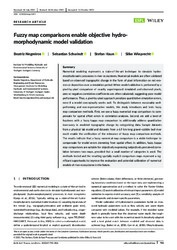Fuzzy map comparisons enable objective hydro‐morphodynamic model validation
DOI: https://doi.org/10.1002/esp.5285
Persistent URL: http://resolver.sub.uni-goettingen.de/purl?gldocs-11858/9960
Persistent URL: http://resolver.sub.uni-goettingen.de/purl?gldocs-11858/9960
Supplement: https://github.com/beatriznegreiros/fuzzycorr
Negreiros, Beatriz; Schwindt, Sebastian; Haun, Stefan; Wieprecht, Silke, 2021: Fuzzy map comparisons enable objective hydro‐morphodynamic model validation. In: Earth Surface Processes and Landforms, Band 47, 3: 793 - 806, DOI: 10.1002/esp.5285.
 |
Dokument öffnen: |
Numerical modeling represents a state‐of‐the‐art technique to simulate hydro‐morphodynamic processes in river ecosystems. Numerical models are often validated based on observed topographic change in the form of pixel information on net erosion or deposition over a simulation period. When model validation is performed by a pixel‐by‐pixel comparison of exactly superimposed simulated and observed pixels, zero or negative correlation coefficients are often calculated, suggesting poor model performance. Thus, a pixel‐by‐pixel approach penalizes quantitative simulation errors, even if a model conceptually works well. To distinguish between reasonably well‐performing and non‐representative models, this study introduces and tests fuzzy map comparison methods. First, we use a fuzzy numerical map comparison to compensate for spatial offset errors in correlation analyses. Second, we add a level of fuzziness with a fuzzy kappa map comparison to additionally address quantitative inaccuracy in modeled topographic change by categorizing data. Sample datasets from a physical lab model and datasets from a 6.9 km long gravel–cobble bed river reach enable the verification of the relevance of fuzzy map comparison methods. The results indicate that a fuzzy numerical map comparison is a viable technique to compensate for model errors stemming from spatial offset. In addition, fuzzy kappa map comparisons are suitable for objectively expressing subjectively perceived correlation between two maps, provided that a small number of categories is used. The methods tested and the resulting spatially explicit comparison maps represent a significant opportunity to improve the evaluation and potential calibration of numerical models of river ecosystems in the future. To distinguish between reasonably well‐performing and non‐representative hydro‐morphodynamic models, this study introduces and tests fuzzy map comparison methods. Datasets from a physical lab model and a 6.9 km long gravel–cobble bed river stretch enable the verification of the relevance of the novel methods. A fuzzy numerical map comparison is a viable technique to compensate for model errors stemming from spatial offset. In addition, fuzzy kappa map comparisons are suitable for objectively expressing subjectively perceived correlation between two maps.
Statistik:
ZugriffsstatistikSammlung:
- Geographie, Hydrologie [454]
This is an open access article under the terms of the Creative Commons Attribution License, which permits use, distribution and reproduction in any medium, provided the original work is properly cited.

